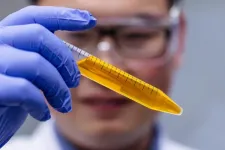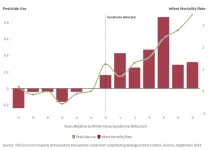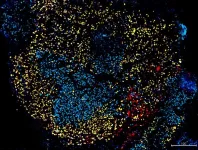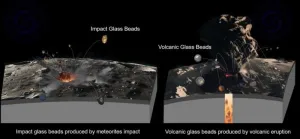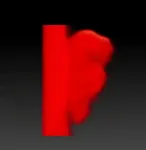(Press-News.org) In a pioneering new study, researchers made the skin on the skulls and abdomens of live mice transparent by applying to the areas a mixture of water and a common yellow food coloring called tartrazine.
Dr. Zihao Ou, assistant professor of physics at The University of Texas at Dallas, is lead author of the study, published in the Sept. 6 print issue of the journal Science.
Living skin is a scattering medium. Like fog, it scatters light, which is why it cannot be seen through.
“We combined the yellow dye, which is a molecule that absorbs most light, especially blue and ultraviolet light, with skin, which is a scattering medium. Individually, these two things block most light from getting through them. But when we put them together, we were able to achieve transparency of the mouse skin,” said Ou, who, with colleagues, conducted the study while he was a postdoctoral researcher at Stanford University before joining the UT Dallas faculty in the School of Natural Sciences and Mathematics in August.
“For those who understand the fundamental physics behind this, it makes sense; but if you aren’t familiar with it, it looks like a magic trick,” Ou said.
The “magic” happens because dissolving the light-absorbing molecules in water changes the solution’s refractive index — a measure of the way a substance bends light — in a way that matches the refractive index of tissue components like lipids. In essence, the dye molecules reduce the degree to which light scatters in the skin tissue, like dissipating a fog bank.
In their experiments with mice, the researchers rubbed the water and dye solution onto the skin of the animals’ skulls and abdomens. Once the dye had completely diffused into the skin, the skin became transparent. The process is reversible by washing off any remaining dye. The dye that has diffused into the skin is metabolized and excreted through urine.
“It takes a few minutes for the transparency to appear,” Ou said. “It’s similar to the way a facial cream or mask works: The time needed depends on how fast the molecules diffuse into the skin.”
Through the transparent skin of the skull, researchers directly observed blood vessels on the surface of the brain. In the abdomen, they observed internal organs and peristalsis, the muscle contractions that move contents through the digestive tract.
The transparent areas take on an orangish color, Ou said. The dye used in the solution is commonly known as FD&C Yellow #5 and is frequently used in orange- or yellow-colored snack chips, candy coating and other foods. The Food and Drug Administration certifies nine color additives — tartrazine is one — for use in foods.
“It’s important that the dye is biocompatible — it’s safe for living organisms,” Ou said. “In addition, it’s very inexpensive and efficient; we don’t need very much of it to work.”
The researchers have not yet tested the process on humans, whose skin is about 10 times thicker than a mouse’s. At this time it is not clear what dosage of the dye or delivery method would be necessary to penetrate the entire thickness, Ou said.
“In human medicine, we currently have ultrasound to look deeper inside the living body,” Ou said. “Many medical diagnosis platforms are very expensive and inaccessible to a broad audience, but platforms based on our tech should not be.”
Ou said one of the first applications of the technique will likely be to improve existing research methods in optical imaging.
“Our research group is mostly academics, so one of the first things we thought of when we saw the results of our experiments was how this might improve biomedical research,” he said. “Optical equipment, like the microscope, is not directly used to study live humans or animals because light can’t go through living tissue. But now that we can make tissue transparent, it will allow us to look at more detailed dynamics. It will completely revolutionize existing optical research in biology.”
In his new Dynamic Bio-imaging Lab at UTD, Ou will continue the research he started with Dr. Guosong Hong, assistant professor of materials science and engineering at Stanford and a corresponding author of the study. Ou said the next steps in the research will include understanding what dosage of the dye molecule might work best in human tissue. In addition, the researchers are experimenting with other molecules, including engineered materials, that could perform more efficiently than tartrazine.
Study authors from Stanford, including co-corresponding author Dr. Mark Brongersma, the Stephen Harris Professor in the Department of Materials Science and Engineering, were funded by grants from federal agencies including the National Institutes of Health, the National Science Foundation and the Air Force Office of Scientific Research. As an interdisciplinary postdoctoral scholar, Ou was supported by the Wu Tsai Neuroscience Institute at Stanford. The researchers have applied for a patent on the technology.
Dr. Zihao Ou
Dr. Zihao Ou earned a Bachelor of Science in physics from the University of Science and Technology of China and a doctorate in materials science and engineering from the University of Illinois Urbana-Champaign. His doctoral research focused on electron microscopy, an imaging technology that uses beams of electrons, instead of light, to produce high-resolution, magnified images of biological and nonbiological specimens.
“I know my field very well, but after I finished my PhD, I wanted to do something that would have more of an impact on more people, rather than limit myself to materials science,” Ou said. “So I decided to learn some biological imaging techniques and bring my background in physics and materials science to biomedical science. As a postdoc, I believe my background in physical science brought a unique perspective to our biological imaging research.”
Ou said he came to UT Dallas for that same cross-disciplinary experience.
END
Yellow dye solution makes tissue transparent on living animals
2024-09-05
ELSE PRESS RELEASES FROM THIS DATE:
The collapse of bat populations led to more than a thousand infant deaths
2024-09-05
Bats are considered a natural pesticide, widely relied on by farmers as an alternative to chemical pesticides to protect their crops from insects. But since 2006, many bat populations have collapsed in counties in North America due to an invasive fungus found in the caves bats use during the day and throughout winter that causes what is known as White-Nose Syndrome. A new study in Science uses their sudden collapse to explore whether farmers turned to chemical pesticides, and whether doing so impacts human health. It finds that farmers did increase their pesticide use, leading to more than 1,000 infant deaths.
“Bats ...
Emotional contagion promotes resilience via serotonin release in mice
2024-09-05
“Bystander” mice that briefly watched other mice be harmed show fewer signs of behavioral despair when faced with their own harmful event, compared to mice who do not observe their fellow mice being harmed. The negative emotional contagion experienced by the bystander mice appears to build resilience against a depressive-like state, according to new research by Sarah Mondoloni and colleagues. Mondoloni et al. demonstrate that resilience in these mice requires an increase in serotonin release in a part of the brain called the lateral habenula. “These findings support the notion that, as is the case in humans, graded trauma can be resilience-promoting, enabling ...
Tiny glass beads indicate volcanism on the Moon 120 million years ago
2024-09-05
There were volcanic eruptions on the Moon as recently as 120 million years ago, according to a new analysis of a lunar sample collected by the Chang’e‑5 mission. Samples collected by the Apollo, Luna and Chang’e‑5 missions have previously shown there was widespread basaltic volcanism on the Moon extending from about 4.4 to 2.0 billion years ago. The new findings demonstrate that volcanism persisted much longer than was previously suspected, at least on smaller, more localized scale. Bi-Wen Wang, Qian W.L. Zhang and colleagues sorted through more than 3000 tiny glass beads they recovered from a lunar sample collected by Chang’e‑5, examining the bead’s ...
Injected fibroblasts transform to give thin skin a tough new identity
2024-09-05
The thick and tough skin on our palms and soles, called volar skin, stands up well under high-pressure conditions. This type of skin would be welcome on the limb stumps of amputees, since these points of contact with prostheses are covered in thin, non-volar skin that can be damaged over time. Now, Sam Lee and colleagues demonstrate that an injection of volar fibroblasts into non-volar skin in a group of human volunteers can promote volar features in the thin skin that last up to five months. Based on their analysis, Lee et al. are now enrolling amputees in a phase 2 clinical trial to further explore volar fibroblasts as a future ...
Novel study reveals how aging immune system fuels cancer growth, potentially opening new avenues for prevention
2024-09-05
New York, NY [September 5, 2024]—A novel study by researchers at the Icahn School of Medicine at Mount Sinai addresses a critical yet under-explored question in cancer research: Why is aging the biggest risk factor for cancer? The study reveals how an aging immune system spurs tumor growth, offering new insights into cancer prevention and treatment, especially for older adults.
Details on the findings were reported in the September 5 Online First Release of Science [DOI:10.1126/science.adn0327]. In preclinical models, the research team found that anakinra, a drug typically used for inflammatory conditions such as rheumatoid arthritis, can be repurposed to block harmful signals between ...
Researchers prove 120-million-year-old volcanism on moon
2024-09-05
Extensive geologic evidence of ancient volcanic activity can be found on the Moon, but how long this volcanism persisted has been unclear. However, Prof. LI Qiuli’s Lab at the Institute of Geology and Geophysics of the Chinese Academy of Sciences (IGGCAS) has recently identified three volcanic glass beads from lunar soil samples collected by the Chang’e-5 mission. Their research shows that the beads were formed 123±15 million years ago (Ma), thus representing the youngest lunar ...
State-by-state data boosts bird conservation planning
2024-09-05
ITHACA, N.Y. – New data summaries from the Cornell Lab of Ornithology’s eBird platform will help state wildlife planners assess the status of bird populations that live in or pass through their state – a crucial tool in protecting species.
A team of data scientists at eBird, the participatory science platform, has packaged summaries covering every bird species, in every state, and made them available online for free. These data summaries will help states prepare their federally required ...
Study on E. coli outbreak in the UK demonstrates increasing impact of climate change on public health and food security
2024-09-05
A study published in Eurosurveillance to investigate an outbreak of Shiga toxin-producing Escherichia coli (STEC) O157:H7 in the UK identified contaminated lettuce as the most likely source of the infection, and determined that heavy rainfall and flooding may have carried STEC from animal faeces to the lettuce crops. More heavy rainfall events are expected due to climate change in the future, leading to increased impacts on health and food security.
Ahead of Field Epidemiology Day 2024, this study demonstrates the value of field investigations in quickly responding to outbreaks, improving preparedness, and protecting public health, and possible ...
Using 3D imaging to transform plastic waste recycling
2024-09-05
In a global first, University of Waterloo researchers have used 3D imaging technology to understand the fine details of microplastics, paving the way for more effective methods of plastic waste recycling.
Micro and nanoplastics, tiny particles of plastic that come from the breakdown of larger plastic items, have become an exponentially worsening environmental crisis. Due to their difficulties in safely decomposing, plastic pollution poses significant threats to ecosystems, wildlife and human health.
Scientists have struggled to understand the exact process of ...
Case for inflammatory memory for hematopoietic stem and progenitor cells in AML niche
2024-09-05
“In this research perspective, we discuss recent work from our lab describing an active role of HSPCs in AML and the potential implications.”
BUFFALO, NY- September 5, 2024 – A new research perspective was published in Oncotarget's Volume 15 on September 4, 2024, entitled, “Trained and ready - the case for an inflammatory memory for hematopoietic stem and progenitor cells in the AML niche.”
As noted in the abstract of this paper, lifelong hematopoiesis is sustained by the crosstalk between hematopoietic stem and progenitor cells (HSPCs) and specialized bone marrow ...
